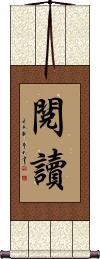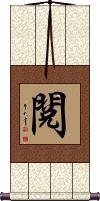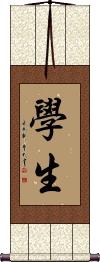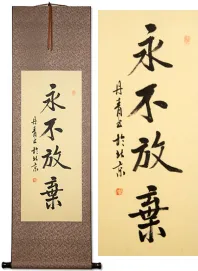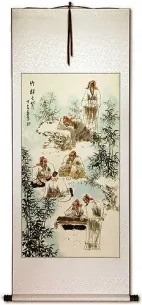Many custom options...
And formats...

Read Reading in Chinese / Japanese...
Buy a Read Reading calligraphy wall scroll here!
Personalize your custom “Read Reading” project by clicking the button next to your favorite “Read Reading” title below...
Read / Reading
Read
閱 is a Chinese character that means to read. It can also refer to observing (the world, and learning from it), or gaining life experiences. 閱 is a good character to relay the idea of being “well-read,” which can include reading books, studying, and learning through experience.
The dictionary definition also includes: to inspect; to review; to peruse; to go through; to experience.
Technically, this is also a Japanese Kanji but only some Japanese Buddhists use it (most of the population will not recognize it).
In Chinese and Japanese Buddhism, this means examining, inspecting, and/or looking over.
Better to Travel 10,000 Miles than Read 10,000 Books
行万里路胜读万卷书 translates a few ways:
To travel ten thousand miles beats reading ten-thousand books.
Better to travel ten thousand li than to read ten thousand books. (a “li” is an ancient Chinese mile)
Traveling thousands of miles is better than reading thousands of books.
No matter how you slice it, this Chinese proverb is claiming that experience is more profound and meaningful than what you can get from a book. Go do it! Don't just read about it.
Student
學生 is how to write “student” in Chinese, pre-WWII Japanese Kanji, and old Korean Hanja.
If you are a “student of life,” this might be an interesting wall scroll to hang in your reading room.
The first character means “study” or “learning.”
The second character means “life” or “birth.” Don't read too much into that second character unless you decide that this means “the birth of studies” or “the life of learning.” Everyone in China, Japan (and those who can read Hanja in Korea) will just read this word with the meaning of “student.”
If you put the character for “little” in front of this word, it becomes “elementary school student.” Prefixed with “middle,” it becomes “middle school student.” Prefixed with “big,” it becomes “university student” (though when these two characters for student are seen alone, it often suggests “university student”). The term “high school student” is written differently.
![]() There is a very common simplified version of the first character for this word. You will see this form in modern Japan and mainland China, Singapore, and other places. If you want this simplified version, please click on the character shown to the right instead of the "select and customize" button above.
There is a very common simplified version of the first character for this word. You will see this form in modern Japan and mainland China, Singapore, and other places. If you want this simplified version, please click on the character shown to the right instead of the "select and customize" button above.
Diligent Study Proverb
Drill a hole in the wall to get light to read by.
鑿壁偷光 is a Chinese proverb that means “Bore a hole in the wall to make use of the neighbor's light to study.”
This is a nice gift for a very studious person.
Kuang Heng was born during the Western Han period. He has been very fond of reading ever since he was young. However, he could not attend school since his family was poor, and he had to borrow books from people to learn.
To borrow these books, he normally did chores for people who had them. When he became older, he had to work in the field from sunrise to sunset since his family's financial situation did not improve. Thus, he tried to study at night, but he had no lamp.
One day, he noticed the light from the neighbor's house coming through a crack in the wall. This made him very happy, so he dug a larger hole from the crack and read in the light that shone through. This diligent study eventually made him an accomplished person.
This in-stock artwork might be what you are looking for, and ships right away...
Gallery Price: $100.00
Your Price: $49.88
Not the results for read reading that you were looking for?
Below are some entries from our dictionary that may match your read reading search...
| Characters If shown, 2nd row is Simp. Chinese |
Pronunciation Romanization |
Simple Dictionary Definition |
閱讀 阅读 see styles |
yuè dú yue4 du2 yüeh tu |
More info & calligraphy: Read / Reading |
上口 see styles |
shàng kǒu shang4 kou3 shang k`ou shang kou jouguchi / joguchi じょうぐち |
to be able to read aloud fluently; to be suitable (easy enough) for reading aloud (place-name, surname) Jōguchi |
可讀 可读 see styles |
kě dú ke3 du2 k`o tu ko tu |
enjoyable to read; worth reading; readable; able to be read; legible; readable |
必読 see styles |
hitsudoku ひつどく |
(noun - becomes adjective with の) must-read; required reading |
泛讀 泛读 see styles |
fàn dú fan4 du2 fan tu |
(language education) to read swiftly, aiming to get the gist; extensive reading |
積読 see styles |
tsundoku つんどく |
(noun/participle) (1) buying books and not reading them; stockpiling books; (2) books bought but not read |
笑覧 see styles |
shouran / shoran しょうらん |
(noun, transitive verb) (humble language) (used when asking someone to read something one has written) (your) reading (of my work) |
笑読 see styles |
shoudoku / shodoku しょうどく |
(noun, transitive verb) (used when asking someone to read something one has written) (See 笑覧) (your) reading (of my work) |
精讀 精读 see styles |
jīng dú jing1 du2 ching tu |
to read carefully and thoroughly; intensive reading |
訓む see styles |
yomu よむ |
(transitive verb) (See 読む・6) to read (a kanji) with its native Japanese reading |
読む see styles |
yomu よむ |
(transitive verb) (1) to read; (transitive verb) (2) to recite (e.g. a sutra); to chant; (transitive verb) (3) to predict; to guess; to forecast; to read (someone's thoughts); to see (e.g. into someone's heart); to divine; (transitive verb) (4) to decipher; (transitive verb) (5) (now mostly used in idioms) (See さばを読む) to count; to estimate; (transitive verb) (6) (also written as 訓む) (See 訓む) to read (a kanji) with its native Japanese reading |
讀破 读破 see styles |
dú pò du2 po4 tu p`o tu po |
to read extensively and thoroughly; nonstandard pronunciation of a Chinese character, e.g. the reading [hao4] in 愛好|爱好[ai4 hao4] rather than the usual [hao3] |
轉經 转经 see styles |
zhuǎn jīng zhuan3 jing1 chuan ching tengyō |
To recite a scripture; to scan a scripture by reading the beginning, middle, and end of each chapter; cf. 轉大. To roll or unroll a scripture roll. To copy a scripture. 轉藏; 轉讀 are similar in meaning. |
門經 门经 see styles |
mén jīng men2 jing1 men ching mongyō |
The funeral service read at the house-door. |
つん読 see styles |
tsundoku つんどく |
(noun/participle) (1) buying books and not reading them; stockpiling books; (2) books bought but not read |
必読書 see styles |
hitsudokusho ひつどくしょ |
must-read (book); required reading |
積ん読 see styles |
tsundoku つんどく |
(noun/participle) (1) buying books and not reading them; stockpiling books; (2) books bought but not read |
読解力 see styles |
dokkairyoku どっかいりょく |
reading comprehension; ability to read and understand |
一目十行 see styles |
yī mù shí háng yi1 mu4 shi2 hang2 i mu shih hang ichimokujuugyou / ichimokujugyo いちもくじゅうぎょう |
ten lines at a glance (idiom); to read very rapidly (yoji) outstanding reading ability; one glance, ten lines |
再読文字 see styles |
saidokumoji さいどくもじ |
(e.g. 将 is read as「まさに...んとす」) single kanji that is read twice (with different pronunciations) in the Japanese reading of Chinese texts |
巻を追う see styles |
kanoou / kanoo かんをおう |
(exp,v5u) to read volume by volume; to go on reading |
既読無視 see styles |
kidokumushi きどくむし |
(noun, transitive verb) (colloquialism) (See 既読スルー) reading but not responding to a text message (in a chat application); leaving (someone) on read |
法華八講 see styles |
hokkehakkou / hokkehakko ほっけはっこう |
Buddhist service in which the eight scrolls of the Lotus Sutra are read one scroll at a time (one morning and one evening reading each day for four days with a different reciter each time) |
読みきる see styles |
yomikiru よみきる |
(transitive verb) to finish reading; to read through |
読み切る see styles |
yomikiru よみきる |
(transitive verb) to finish reading; to read through |
読み終る see styles |
yomiowaru よみおわる |
(Godan verb with "ru" ending) to finish reading; to read through |
音で読む see styles |
ondeyomu おんでよむ |
(exp,v5m) (See 音・おん・4) to read kanji using the "on" reading |
既読スルー see styles |
kidokusuruu / kidokusuru きどくスルー |
(noun, transitive verb) (colloquialism) (See スルー・1) reading but not responding to a text message (in a chat application); leaving (someone) on read |
読み終わる see styles |
yomiowaru よみおわる |
(Godan verb with "ru" ending) to finish reading; to read through |
Variations: |
yomiayamaru よみあやまる |
(transitive verb) (1) to misread (a name, kanji, etc.); to read incorrectly; to mispronounce (when reading); (transitive verb) (2) to misread (a situation, trend, etc.); to misinterpret; to misjudge |
Click here for more read reading results from our dictionary
The following table may be helpful for those studying Chinese or Japanese...
| Title | Characters | Romaji (Romanized Japanese) | Various forms of Romanized Chinese | |
| Read Reading | 閱讀 阅读 | yuè dú / yue4 du2 / yue du / yuedu | yüeh tu / yüehtu | |
| Read | 閱 阅 | yuè / yue4 / yue | yüeh | |
| Better to Travel 10,000 Miles than Read 10,000 Books | 行萬里路勝讀萬捲書 行万里路胜读万卷书 | xíng wàn lǐ lù shèng dú wàn juǎn shū xing2 wan4 li3 lu4 sheng4 du2 wan4 juan3 shu1 xing wan li lu sheng du wan juan shu | hsing wan li lu sheng tu wan chüan shu | |
| Student | 學生 学生 | gakusei | xué shēng xue2 sheng1 xue sheng xuesheng | hsüeh sheng hsüehsheng |
| Diligent Study Proverb | 鑿壁偷光 凿壁偷光 | záo bì tōu guāng zao2 bi4 tou1 guang1 zao bi tou guang zaobitouguang | tsao pi t`ou kuang tsaopitoukuang tsao pi tou kuang |
|
| In some entries above you will see that characters have different versions above and below a line. In these cases, the characters above the line are Traditional Chinese, while the ones below are Simplified Chinese. | ||||
Successful Chinese Character and Japanese Kanji calligraphy searches within the last few hours...
